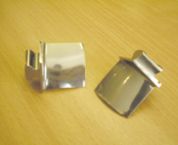E-Archive
Articles
in Vol. 3 - February Issue - Year 2002
Vibratory Finishing to Super-polished Levels with Keramo©

Rösler is one of the world-wide leading vibratory finishing companies. Vibratory and centrifugal finishing machines are produced along with precision ceramic and plastic media, compounds and effluent treatment systems as well as consumables at our production facilities in Germany. They have 15 international sales centres around the world and are represented in the aerospace industry by the DASS organisation.
For the past twenty years Rösler has supported the aerospace component manufacturing and repair industries world-wide. Offering abrasive media based processes with an aluminium oxide a number of major customers including Rolls-Royce, Snecma, MTU, Lufthansa and Blades Technologies have been established. However, opportunities to present and develop new process methods have been few and far between and tried and tested methods were largely relied upon to achieve surface finish targets.
In 1997, British Airways undertook an exercise with Rolls-Royce to improve the specific fuel consumption and E.G.T. margins on their RB211-524G/H fleet. Surface finish was deemed to be an important factor in achieving the improvements. Rösler had been discussing improved medias and processes with Rolls-Royce who entered into a series of trials with the following criteria in mind:
-The process must be able to finish components to super-polished levels
-The process must be acid-free to prevent risk of component material weakening through hydrogen embrittlement
-The process must be repeatable and so should remove as little material as possible from the chordal width of components
-The process must be capable of finishing singular and multi-span components
-The process was to be universally applicable throughout the engine, on a range of materials and a range of component sizes
Extensive Series of Trials on IP and LP Compressor Blades and Vanes
The German manufacturer proposed it's Keramo(r) process which had been developed to finish titanium, stainless steel and chromium steels. An extensive series of trials were entered into and Keramo(r) proved itself as the process capable of meeting all of the criteria. Due to the impressive results demonstrated on IP and LP compressor blades and vanes the process was then singularly selected by Rolls-Royce to complete testing on all stages of the engine including; VIGV's, coated stage 1-4 compressor vanes, fan blades, assembled stator stages 5, 6 and OGV, turbine blades and stators as well as NGV's.
Further to the results of the trials the process has been approved by Rolls-Royce and specified by a number of major airlines for their RB211 engines. The reason for this has been the results the Keramo process can achieve. These are:
-Compressor blades and rotors to
<8 microinches (<0,2 micrometers)
-Multispan compressor assemblies
< 12 microinches (<0,3 micrometers)
-Wide chord fan blades <10 microinches (<0,25 micrometers)
-Compressor assemblies stage 5, 6 and OGV's <15 microinches (<0,375 micrometers)
-Turbine blades and NGV's <20 microinches (<0,5 micrometers)
The thorough laboratory testing from Rolls-Royce also concluded that this suggested process proved to have:
-No intergranular attack on any material type used in components in the engine
-No hydrogen embrittlement of component material.
-Minimum chordal width reduction (less than 1/2 thousandths (0,0127mm) chordal width reduction against typical 3 to 4 thousandths (0,0762 to 0,01026mm) reduction with abrasive media, 4 to 5 thousandths (0,1016mm to 0,127mm) reduction with chemical accelerated process
-Minimum effect on compressive stress layers after vapour blasting / peening due to minimal material loss
Paste added to the Media Mass
With regards to the process it utilises a high density, non-abrasive porcelain media and paste (containing the abrasive). The paste is added to the media mass and 'cuts back' the surface of the components for a period of time. At the end of this the paste is removed from the bowl with a water rinse. The components may then be removed with a matt grey appearance or they may be burnished, using the same media and FC120 compound, dependent upon customer preference (the burnish improving the final surface by some 2 to 3 microinches). It is often possible to run the process in your existing vibratory finishing bowls, be they trough type or rotary bowl machines and we would be happy to assist you setting this up and training your operators. Process times can range between 3 hours total (for all 3 stages) for individual compressor blades and vanes through to 61/2 hours total (for all 3 stages) for assemblies such as OGV's or the half ring assemblies stages 5 and 6 (IP compressor vanes).
The process itself is the quickest of it's kind and has benefited from the work between Rösler and Rolls-Royce. Process times have been reduced from original 13 hour runs to 3 hours in some cases and the process continues to be refined further. Many airlines have demonstrated interest and commitment to the Keramo(r) process on further engine types and testing continues to prove the process' consistency and application on all component types.
For Information:
Rösler UK
Unity Grove, School Lane
Knowsley Business Park
Prescot Merseyside, L34 9GT, UK
Tel: +44.151.482 0444
Fax +44.151.482 4400
E-mail: rosler@rosleruk.com
www.rosleruk.com



























